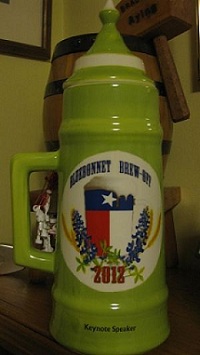 Sometimes beer and blogging mix and sometimes they don’t. This past weekend I was way too busy at the Bluebonnet Brew-Off in Dallas to write deer diary notes on Twitter, let alone blog. And that’s a good thing.
Sometimes beer and blogging mix and sometimes they don’t. This past weekend I was way too busy at the Bluebonnet Brew-Off in Dallas to write deer diary notes on Twitter, let alone blog. And that’s a good thing.
I’m not sure that you’d say an easy way to get a treasured stein from Bluebonnet is to make the keynote speech and return the next morning with a technical presentation, but it somehow seems easier than winning one. The Bluebonnet had 1,805 entries this year. Steins go to first place winners. You need to brew a really good beer and be equally lucky to win one of these.
The Bluebonnet is, in fact, the biggest one-site homebrew competition anywhere, but really bigger than that. Texas big, for sure. Something like 800 people attended the Friday night tastings (commercial beers, followed by the “room crawl,” some not so good homebrews and many you’d be happy to find packaged it your local beer store). They needed five large buses for the Saturday afternoon pub crawl.
I’m back in the air tomorrow, so it will likely be a while before I can mentally organize some thoughts about homebrewers, or really the culture surrounding homebrewing, and to steal an idea from my friend Evan Rail, why they matter.
Earlier this month Lew Bryson mentioned skepticism about “the vaunted impact of homebrewers on American craft brewing.” Alan McLeod ran with it a bit, and Lew added some clarification.
I don’t disagree that some homebrewers occasionally get carried away, about almost anything and everything, and sometimes not always in a charming way. But the view from here, imperfect as it may be, is that homebrewers are an essential part of the evolving beer culture, changing beer landscape (tectonic plates and all), however you want to characterize what’s going on.
More on this . . . eventually. Please be civil with comments, since my ability to participate will be limited.